登録情報 データベース : PDB / ID : 7lciタイトル PF 06882961 bound to the glucagon-like peptide-1 receptor (GLP-1R):Gs complex (Guanine nucleotide-binding protein ...) x 3 Glucagon-like peptide 1 receptor キーワード / / 機能・相同性 分子機能 ドメイン・相同性 構成要素
/ / / / / / / / / / / / / / / / / / / / / / / / / / / / / / / / / / / / / / / / / / / / / / / / / / / / / / / / / / / / / / / / / / / / / / / / / / / / / / / / / / / / / / / / / / / / / / / / / / / / / / / / / / / / / / / / / / / / / / / / / / / / / / / / / / / / / / / / / / / / / / / / / / / / / / / / / / / / / / / 生物種 Homo sapiens (ヒト)手法 / / / 解像度 : 2.9 Å データ登録者 Belousoff, M.J. / Johnson, R.M. / Drulyte, I. / Yu, L. / Kotecha, A. / Danev, R. / Wootten, D. / Zhang, X. / Sexton, P.M. 資金援助 組織 認可番号 国 Australian Research Council (ARC) IC200100052 National Health and Medical Research Council (NHMRC, Australia) 1126857 National Health and Medical Research Council (NHMRC, Australia) 1184726 National Health and Medical Research Council (NHMRC, Australia) 1150083 Japan Science and Technology 18069571
ジャーナル : Structure / 年 : 2021タイトル : Evolving cryo-EM structural approaches for GPCR drug discovery.著者 : Xin Zhang / Rachel M Johnson / Ieva Drulyte / Lingbo Yu / Abhay Kotecha / Radostin Danev / Denise Wootten / Patrick M Sexton / Matthew J Belousoff / 要旨 : G protein-coupled receptors (GPCRs) are the largest class of cell surface drug targets. Advances in stabilization of GPCR:transducer complexes, together with improvements in cryoelectron microscopy ... G protein-coupled receptors (GPCRs) are the largest class of cell surface drug targets. Advances in stabilization of GPCR:transducer complexes, together with improvements in cryoelectron microscopy (cryo-EM) have recently been applied to structure-assisted drug design for GPCR agonists. Nonetheless, limitations in the commercial application of these approaches, including the use of nanobody 35 (Nb35) to aid complex stabilization and the high cost of 300 kV imaging, have restricted broad application of cryo-EM in drug discovery. Here, using the PF 06882961-bound GLP-1R as exemplar, we validated the formation of stable complexes with a modified Gs protein in the absence of Nb35. In parallel, we compare 200 versus 300 kV image acquisition using a Falcon 4 or K3 direct electron detector. Moreover, the 200 kV Glacios-Falcon 4 yielded a 3.2 Å map with clear density for bound drug and multiple structurally ordered waters. Our work paves the way for broader commercial application of cryo-EM for GPCR drug discovery. 履歴 登録 2021年1月11日 登録サイト / 処理サイト 改定 1.0 2021年1月20日 Provider / タイプ 改定 1.1 2021年5月19日 Group / カテゴリ Item _citation.country / _citation.journal_abbrev ... _citation.country / _citation.journal_abbrev / _citation.journal_id_ASTM / _citation.journal_id_CSD / _citation.journal_id_ISSN / _citation.pdbx_database_id_DOI / _citation.pdbx_database_id_PubMed / _citation.title / _citation.year 改定 1.2 2021年9月15日 Group / カテゴリ / database_2Item _citation.journal_volume / _citation.page_first ... _citation.journal_volume / _citation.page_first / _database_2.pdbx_DOI / _database_2.pdbx_database_accession
すべて表示 表示を減らす
 データを開く
データを開く 基本情報
基本情報 要素
要素 キーワード
キーワード 機能・相同性情報
機能・相同性情報 Homo sapiens (ヒト)
Homo sapiens (ヒト) データ登録者
データ登録者 オーストラリア,
オーストラリア,  日本, 5件
日本, 5件  引用
引用 ジャーナル: Structure / 年: 2021
ジャーナル: Structure / 年: 2021


 構造の表示
構造の表示 ムービービューア
ムービービューア Molmil
Molmil Jmol/JSmol
Jmol/JSmol ダウンロードとリンク
ダウンロードとリンク ダウンロード
ダウンロード 7lci.cif.gz
7lci.cif.gz PDBx/mmCIF形式
PDBx/mmCIF形式 pdb7lci.ent.gz
pdb7lci.ent.gz PDB形式
PDB形式 7lci.json.gz
7lci.json.gz PDBx/mmJSON形式
PDBx/mmJSON形式 その他のダウンロード
その他のダウンロード 7lci_validation.pdf.gz
7lci_validation.pdf.gz wwPDB検証レポート
wwPDB検証レポート 7lci_full_validation.pdf.gz
7lci_full_validation.pdf.gz 7lci_validation.xml.gz
7lci_validation.xml.gz 7lci_validation.cif.gz
7lci_validation.cif.gz https://data.pdbj.org/pub/pdb/validation_reports/lc/7lci
https://data.pdbj.org/pub/pdb/validation_reports/lc/7lci ftp://data.pdbj.org/pub/pdb/validation_reports/lc/7lci
ftp://data.pdbj.org/pub/pdb/validation_reports/lc/7lci リンク
リンク 集合体
集合体
 要素
要素 Homo sapiens (ヒト) / 遺伝子: GLP1R / 発現宿主:
Homo sapiens (ヒト) / 遺伝子: GLP1R / 発現宿主:  Trichoplusia ni (イラクサキンウワバ) / 参照: UniProt: P43220
Trichoplusia ni (イラクサキンウワバ) / 参照: UniProt: P43220 Homo sapiens (ヒト) / 遺伝子: GNAS, GNAS1, GSP / 発現宿主:
Homo sapiens (ヒト) / 遺伝子: GNAS, GNAS1, GSP / 発現宿主:  Trichoplusia ni (イラクサキンウワバ) / 参照: UniProt: P63092
Trichoplusia ni (イラクサキンウワバ) / 参照: UniProt: P63092 Homo sapiens (ヒト) / 遺伝子: GNB1 / 発現宿主:
Homo sapiens (ヒト) / 遺伝子: GNB1 / 発現宿主:  Trichoplusia ni (イラクサキンウワバ) / 参照: UniProt: P62873
Trichoplusia ni (イラクサキンウワバ) / 参照: UniProt: P62873 Homo sapiens (ヒト) / 遺伝子: GNG2 / 発現宿主:
Homo sapiens (ヒト) / 遺伝子: GNG2 / 発現宿主:  Trichoplusia ni (イラクサキンウワバ) / 参照: UniProt: P59768
Trichoplusia ni (イラクサキンウワバ) / 参照: UniProt: P59768


 試料調製
試料調製 Homo sapiens (ヒト)
Homo sapiens (ヒト) Trichoplusia ni (イラクサキンウワバ)
Trichoplusia ni (イラクサキンウワバ) 電子顕微鏡撮影
電子顕微鏡撮影
 FIELD EMISSION GUN / 加速電圧: 300 kV / 照射モード: FLOOD BEAM
FIELD EMISSION GUN / 加速電圧: 300 kV / 照射モード: FLOOD BEAM 解析
解析 ムービー
ムービー コントローラー
コントローラー









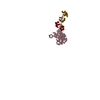
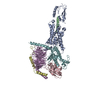

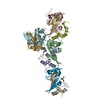
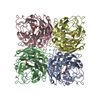
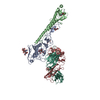
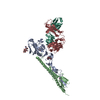
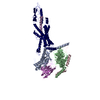
 PDBj
PDBj



















